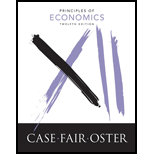
Principles of Economics (12th Edition)
12th Edition
ISBN: 9780134078779
Author: Karl E. Case, Ray C. Fair, Sharon E. Oster
Publisher: PEARSON
expand_more
expand_more
format_list_bulleted
Concept explainers
Question
Chapter 7, Problem 3.1P
(a)
To determine
Total cost of each technique.
(b)
To determine
How may labor units are employed at each level of output.
(c)
To determine
Graphical illustration of total cost.
(d)
To determine
Total cost of each technique.
Expert Solution & Answer
Want to see the full answer?
Check out a sample textbook solution
Students have asked these similar questions
For a firm to maximize profit, it must minimize the cost of producing whatever quantity it produces. Use the isocost and isoquant tools to present a firm that is choosing the optimal levels of labor and capital (i.e., tools) to produce a certain quantity and a certain cost. Then, show in your diagram how this firm would respond if it were to expand and spend more on its inputs, assuming it is best for the firm to become more “capital intensive” as it grows. Comment on WHY a firm might best become more capital intensive as it expands, even when the relative prices of labor and capital remain unchanged.
Suppose that widgets can be produced using two different production techniques, A and B. The following table provides the total input
requirements for each of five different total output levels.
Q = 1
Tech. K L
A
B
Q=2
K L
2
4 1 6
1 3 2 5
Total
Cost
L
K
Assuming that the price of labor (P₁) is $1 and the price of capital (PK) is $3, calculate the total cost of production for each of the five
levels of output using the optimal (least-cost) technology at each level.
Q=3
K L
4
9
4 8
To do this, complete the table below by calculating the total cost of production, filling in the missing values using the optimal (least-cost)
technology at each level. (Enter your responses as whole numbers.)
Q=4
K L
12
5
Total
Cost
How many labor hours (units of labor) would be employed at each level of output? How many machine hours (units of capital)?
To answer this, complete the table below for the units of labor and units of capital that would be used to produce each level of output.
(Enter your…
Suppose that widgets can be produced using two different production techniques, A and B. The following table provides the total input
requirements for each of five different total output levels.
Q = 1
Tech. K L
A
B
Q=2
K L
4 1 6 2
13
Total
Cost
NO
K
2 5
Assuming that the price of labor (P₁) is $1 and the price of capital (P) is $3, calculate the total cost of production for each of the five
levels of output using the optimal (least-cost) technology at each level.
To do this, complete the table below by calculating the total cost of production, filling in the missing values using the optimal (least-cost)
technology at each level. (Enter your responses as whole numbers.)
Q=5
Q=1 Q=2 Q=3 Q=4
$ 20 $ 27
$ 6
$ 11
$36
Q = 3
K L
9 4
4 8
How many labor hours (units of labor) would be employed at each level of output? How many machine hours (units of capital)?
To answer this, complete the table below for the units of labor and units of capital that would be used to produce each level of output.…
Chapter 7 Solutions
Principles of Economics (12th Edition)
Knowledge Booster
Learn more about
Need a deep-dive on the concept behind this application? Look no further. Learn more about this topic, economics and related others by exploring similar questions and additional content below.Recommended textbooks for you

 Exploring EconomicsEconomicsISBN:9781544336329Author:Robert L. SextonPublisher:SAGE Publications, Inc
Exploring EconomicsEconomicsISBN:9781544336329Author:Robert L. SextonPublisher:SAGE Publications, Inc Managerial Economics: A Problem Solving ApproachEconomicsISBN:9781337106665Author:Luke M. Froeb, Brian T. McCann, Michael R. Ward, Mike ShorPublisher:Cengage Learning
Managerial Economics: A Problem Solving ApproachEconomicsISBN:9781337106665Author:Luke M. Froeb, Brian T. McCann, Michael R. Ward, Mike ShorPublisher:Cengage Learning Microeconomics: Principles & PolicyEconomicsISBN:9781337794992Author:William J. Baumol, Alan S. Blinder, John L. SolowPublisher:Cengage Learning
Microeconomics: Principles & PolicyEconomicsISBN:9781337794992Author:William J. Baumol, Alan S. Blinder, John L. SolowPublisher:Cengage Learning




Exploring Economics
Economics
ISBN:9781544336329
Author:Robert L. Sexton
Publisher:SAGE Publications, Inc

Managerial Economics: A Problem Solving Approach
Economics
ISBN:9781337106665
Author:Luke M. Froeb, Brian T. McCann, Michael R. Ward, Mike Shor
Publisher:Cengage Learning

Microeconomics: Principles & Policy
Economics
ISBN:9781337794992
Author:William J. Baumol, Alan S. Blinder, John L. Solow
Publisher:Cengage Learning